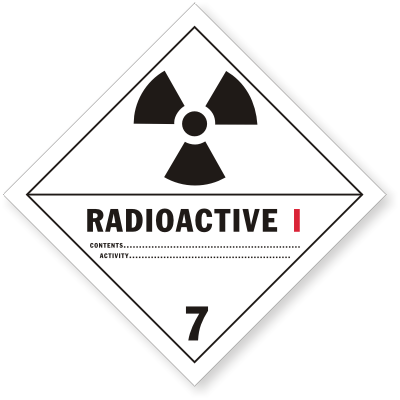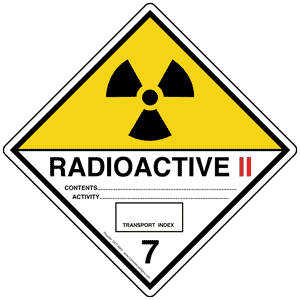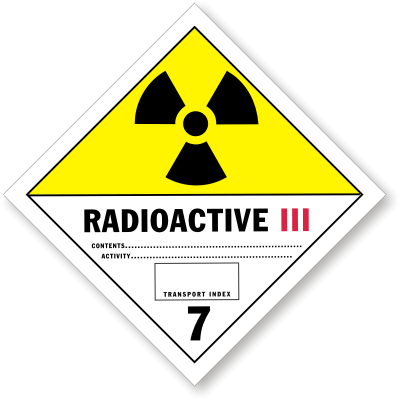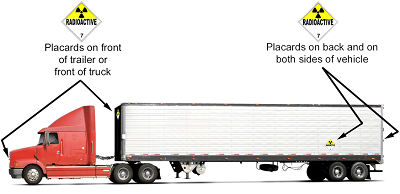Dear Dr. Zoomie: We’re a well-logging company and we ship and transport radioactive materials sometimes and I just found out we’re supposed be labeling our packages. I’m not quite sure how to figure out the right label to use. Can you help me? Thanks!
Yeah – this is a common question and a place where people make a lot of mistakes. First, the chances that your vehicle will be stopped and that you’ll get in trouble for making a mistake – pretty slim odds. On the other hand, you have to follow the rules whether you think you’re going to get caught or not – it’s the right thing to do. Not only that, but if you’re doing things the right way it doesn’t matter if you do get stopped because you’ll be doing things correctly. So here goes!
The first concept you have to learn is the Transport Index (abbreviated TI). The Transport Index is just the radiation dose rate that you measure at a distance of 1 meter from your package, in mR/hr. So if you get a reading of, say, 1.3 mR/hr a meter away from the package then the TI is 1.3; if you put some additional shielding around the same source and reduce the dose rate to 0.5 then the TI (for the exact same source) is reduced to 0.5. So the TI has nothing to do with the amount of radioactivity in the package – it only reflects the radiation dose rate you measure a meter from the package surface.
A few things to remember – alpha radiation can’t even penetrate through a sheet of paper, so if your package contains only alpha radioactivity then your TI will be zero no matter how much radioactivity is present (beta sources are similar – you might get readings from a high-energy beta emitter such as strontium-90, but might have no readings at all from a carbon-14 source). In addition, you have to remember that a neutron-emitting source (such as many well-logging sources) will be emitting radiation that might not be detected by all radiation instruments – you need to use a neutron detector to measure neutron radiation. Oh – and don’t use a Geiger counter to measure radiation dose rates unless it’s an energy-compensated GM; any other sort of GM detector is likely to give erroneous readings.
OK – so once you’ve got the TI figured out then you can get a start on figuring out how to label your package.
There are three labels you have to choose from, White 1, Yellow 2, and Yellow 3.
White 1 Radiation Label

The lowest level of label is a White 1. If the radiation level at the surface of the package (what you would measure by putting your radiation detector on contact with the package surface) is less than 0.5 mR/hr then it can be labeled with the White 1 label. White 1 packages don’t have a Transport Index – by the time you get to a distance of a meter there won’t be anything that you can measure.
Yellow 2 Radiation Label

Next is Yellow 2. You will use a Yellow 2 label for packages with surface radiation dose rates of up to 50 mR/hr and that are less than 1 mR/hr (TI < 1) at a distance of 1 meter.
Yellow 3 Radiation Label

The highest level of label is the Yellow 3. These are used to label any packages with surface radiation dose rates in excess of 50 mR/hr OR for any packages with a TI greater than 1 (that is, where dose rate is higher than 1 mR/hr at a distance of 1 meter from the package).
One thing to keep in mind is that if your sources are expected to be transported a lot (soil density gauges, industrial radiography sources, and well logging sources are frequently transported from job site to job site), the carrying cases or packaging will very likely to be properly labeled by the manufacturer already. In that case, all you need to do is to check the radiation dose rates to make sure they’re what you expect to see (if the shielding is compromised somehow dose rates might be too high; if the source falls out of the shield then the dose rates will be too low).
Now that you’ve (hopefully) figured out how to label your packages, you need to know whether or not you can carry a particular package inside your vehicle – or someone else’s. Here, what matters is whether or not the vehicle is a common carrier (e.g. Federal Express) or an exclusive use vehicle (this can be your company truck or a contract carrier); it also matters whether or not the vehicle is open (a flat-bed truck or in the bed of a pickup truck that’s not covered).
If you’re shipping a radioactive package with a common carrier then the radiation dose rate has to be less than 200 mR/hr on contact with the exterior of the package and it has to have a TI of less than 10 (remember – this means that the dose rate measured 1 meter from the package can’t exceed 10 mR/hr).
If you’re transporting the radioactive materials in your own vehicle or with a contract carrier then you have a little more latitude. Here, if the vehicle is closed, you can have surface radiation dose rates up to 1 R/hr (1000 mR/hr) and up to 200 mR/hr on contact with the vehicle’s surface. For an open vehicle you’re limited to 200 mR/hr on contact with the package surface as well as at the edge of the vehicle’s bed. In both cases, you can’t exceed a dose rate of 10 mR/hr two meters from the side of the vehicle and no more than 2 mR/hr in the cab.
The last thing to mention is that some vehicles will have to be placarded – specifically, any vehicle carrying a Yellow 3 package as well as trucks carrying a category of radioactive materials called “low specific activity” (or LSA) material – this primarily comes from remediation of contaminated sites.

Remember – there’s a lot more to radioactive materials transportation than labeling the packages and placarding the trucks properly. I’ll have some more postings on the topic, and you can also find information in a booklet published online by the Nuclear Regulatory Commission.
If you’re interested in attending a training course Nevada Technical Associates conducts courses on the topic of Transportation of Radioactive Materials and holds courses several times a year.